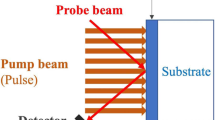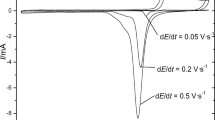Abstract
A new method is used to measure the direct-current (Faradic) resistance of a single electrode/electrolyte interface. The method employs a constant-current pulse and a potential-sensing electrode. By choosing a sufficiently long pulse duration, the voltage between the test and potential-sensing electrode exhibits a three-phase response. In the steady-state phase, the voltage measured is equal to the current flowing through the electrode Faradic resistance and the resistance of the electrolyte between the test and potential-sensing electrode. By measuring this latter resistance with a high-frequency sinusoidal alternating current, the voltage drop in the electrolyte is calculated and subtracted from the voltage measured between the test and potential-sensing electrode, thereby allowing calculation of the Faradic resistance. By plotting the reciprocal of the Faradic resistance against current density and fitting the data points to a third-order polynomial, it is possible to determine the zero-current density (Faradic) resistance. This technique was used to determine the Faradic resistance of electrodes (0·1 cm2) of stainless-steel, platinum, platinum-iridium and rhodium in 0·9 per cent NaCl at 25°C. The zero current Faradic resistance is lowest for platinum (30·3 kΩ), slightly higher for platinum-iridium (47·6kΩ), much higher for rhodium (111 kΩ) and highest for type 316 stainless-steel (345 kΩ). In all cases, the Faradic resistance decreases dramatically with increasing current density.
Similar content being viewed by others
References
Block, M. T. (1968) The electrical and biological properties of tungsten microelectrodes.Med. & Biol. & Eng.,6, 517–525.
De Boer, R. W. andvan Oosterom, A. (1978) Electrical properties of platinum electrodes: impedance measurements and time-domain analysis.Med. & Biol. Eng. & Comput.,16, 1–10.
Faraday, M. (1834) Experimental researches in electricity.Phil. Trans. R. Soc. London,124, 77–122.
Geddes, L. A., Baker, L. E. andMoore, A. G. (1969) Optimum electrolytic chloriding of silver electrodes.Med. & Biol. Eng.,7, 49–56.
Geddes, L. A., Da Costa, C. P. andWise, G. (1971) The impedance of stainless-steel electrodes. —Ibid.,9, 511–521.
Geddes, L. A. (1975) Characteristics of defibrillating electrodes and living tissue. Proc. Cardioc Defib. Conf., Purdue University, West Lafayette, Indiania, USA, 1st–3rd Oct., 49–53.
Grahame, D. C. (1952) Mathematical theory of the Faradic admittance.J. Electrochem. Soc.,99, (12) 370C-385C.
Greatbatch, W. (1967) Electrochemical polarization of physiological electrodes.Med. Res. Eng.,6, (2), 13–17.
Creatbatch, W. andChardack, W. M. (1968) Myocardial and endocardial electrodes for chronic implantation.Ann. NY Acad. Sci.,148, 234–251.
Greatbach, W., Peirsma, B., Shannon, F. D. andCalhoon, S. W. (1969) Polarization phenomena relating to physiological electrodes. —Ibid.,149, 722–744.
Jaron, D., Briller, S. A., Schwan, H. P. andGeselowitz, D. B. (1969) Nonlinearity of cardiac pacemaker electrodes.IEEE Trans. BME-16, 132–138.
Mansfield, P. B. (1967) Myocardial stimulation.Am. J. Physiol.,212, 1475–1488.
Murdock, C. G. andZimmerman, E. T. (1936) Polarization impedance at low frequencies.Physics,7, 211–219.
Onaral, B. andSchwan, H. P. (1982) Linear and nonlinear properties of platinum electrode polarisation. Part 1. Frequency dependence at very low frequencies.Med. & Biol. Eng. & Comput.,20, 299–306.
Ragheb, T. andGeddes, L. A. (1990) The electrical properties of metallic electrodes. —Ibid.,28, 182–186.
Schwan, H. P. andMaczuk, J. G. (1965) Electrode polarization impedance: limits of linearity. Proc. 18th Ann. Conf. Eng. in Med. & Biol., Paper 5.1, 24.
Schwan, H. P. (1968) Electrode polarization impedance and measurements in biological materials.Ann. NY Acad. Sci.,148, 191–209.
Varley, C. F. (1871) Polarization of metallic surfaces in aqueous solutions.Phil. Trans. R. Soc. London,161, 129–136.
Volta, A. (1793) Account of some discoveries made by Mr Galvani of Bologna with experiments and observations on them. In two letters from Mr Alexander Volta, FRS, Professor of Natural Philosophy in the University of Pavia, to Mr Tiberius Cavallo, FRS,Phil. Trans. R. Soc. London,83, 285–291.
Volta, A. (1800) On the electricity excited by the mere contact of conducting substances of different kinds. In a letter from Mr Alexander Volta, FRS, Professor of Natural Philosophy in the University of Pavia, to the Rt. Hon. Sir Joseph Banks, Bart. KBFRS, —Ibid.,90, 744–746.
Warburg, E. (1899) Über das Verhalten sorgenannter unpolarisbarer Electroden gegen Wechselstrom.Ann. Phys. Chem. 67, 493–499.
Warburg, E. (1901) Über die Polarisationscapacitat des Platins.Ann. Phys.,6, 125–135.
Weinman, J. andMahler, J. (1964) An analysis of electrical properties of metal electrodes.Med. & Biol. Eng.,2, 299–310.
Wien, M. (1896) Über die Polarization bei Wechselstrom. —Ibid.,58, 37–72.
Author information
Authors and Affiliations
Rights and permissions
About this article
Cite this article
Mayer, S., Geddes, L.A., Bourland, J.D. et al. Faradic resistance of the electrode/electrolyte interface. Med. Biol. Eng. Comput. 30, 538–542 (1992). https://doi.org/10.1007/BF02457834
Received:
Accepted:
Issue Date:
DOI: https://doi.org/10.1007/BF02457834




